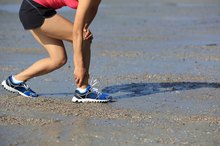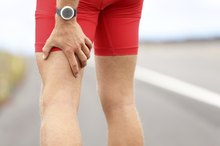Aching Pain on the Inner Thigh From Exercise
Inner thigh pain can be caused by a number of different exercises. Unfortunately, this pain can make it difficult to perform any exercises at all -- it can even make it difficult to perform simple day-to-day tasks. You can prevent or mitigate inner thigh pain caused by exercise in a number of ways so that you can get back to your regular workout routine.
Adductor Strain
The inner thigh muscle is also called the adductor muscle, and it is primarily responsible for turning the toe in while walking or running. It is possible to pull or injure the upper inner thigh or the lower inner thigh while performing different exercises or to simply overwork the muscle by running, hiking or playing sports past the point of fatigue or tensing the muscle to avoid slipping while running or walking on wet surfaces.
Increasing Intensity
Running and Pain in the Tibialis Anterior Muscle
Learn More
One of several causes of inner thigh pain may be due to a groin strain or a groin pull. This often happens to runners and those who play sports -- such as soccer or tennis -- that involve a great deal of running. The inner thigh pain can be mild, caused by a small strain of muscles that connect the thigh bone to the pubic bone. Inner thigh pain can also be moderate to severe, caused by a total rupture of those same muscles. Additionally, you may experience pain on the outside of the inner thigh due to rash caused by the friction of the thighs rubbing together while running on a treadmill or outside.
Preventative Measures
One of the best ways to avoid inner thigh pain from exercise is to completely warm up the muscles before running or playing sports that involve a high amount of running. Next, avoid overtraining as this can overwork the muscle and cause pain or injury. Supportive shoes also help, as does stretching thoroughly after a workout.
At-Home Remedies
Pectoral Pain When Doing Pullups
Learn More
If you experience pain in your inner thigh, your first step should be to rest the leg and avoid running and other exercises that stress the muscle until the pain subsides. If there is slight swelling or if the pain is caused by a rash, apply ice to cool the area to limit the pain and call the doctor to see if the issue is serious enough to come in.
Warning
According to the U.S. National Library of Medicine’s MedlinePlus, you should call your doctor if your leg is swollen or red, if you have a fever in addition to thigh pain, your pain gets worse when you walk or exercise but gets better when you rest, if you have bruises, or if your leg is cold and pale. You should also contact your doctor if the home remedies to reduce pain do not work for you.
Related Articles
References
- Medline Plus: Leg Pain
- The Stretching Institute: Groin Pain, Groin Strain, And Groin Pull Injury
- The Runners' Repair Manual: A Complete Program for Diagnosing and Treating Your Foot, Leg and Back Problems; Barbara Burr, Murray F. Weisenfeld
Writer Bio
Rick Rockwell is a self-employed personal trainer and experienced freelance writer. His articles have been published throughout the Internet. He has more than eight years of experience as a certified personal trainer, group fitness instructor and lifestyle coach. His company, Rockwell Fitness, is dedicated to educating and empowering others to live healthy lifestyles.








